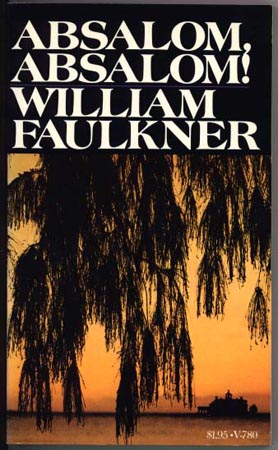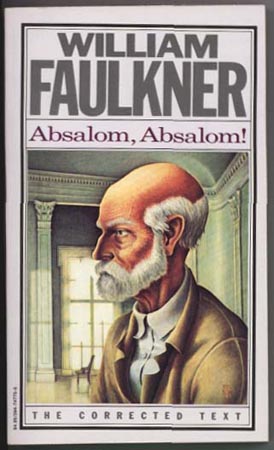

William Faulkner. Absalom, Absalom! New York: Random House, 1936.
Limited, signed edition, number 51 of 300 copies.
The extensive period (1833 to 1910) and the complex narrations that Faulkner used to tell the Sutpen story caused him to create three readers' guides that are included at the end of the text. The first is a "Chronology" that begins with Thomas Sutpen's birth in 1807 and highlights the major events in the story, ending with the fire in 1910 that destroys Sutpen's mansion. The second is a "Genealogy" that lists the principal characters and summarizes each person's birth, family line, marriage and children, business or occupation, and death. The third is a map of Yoknapatawpha County which identifies the twenty-seven places that had figured so far in his fiction. It cost Random House an extra hundred dollars to print the map in two colors and tip it into the 6,000 copies of the first impression.
William Faulkner. Absalom, Absalom! New York: Random House, 1951.
The artists hired for the 1951 Modern Library edition and the 1972 and 1987 Vintage Books editions emphasized again the themes of loneliness, alienation, human insignificance, futility, and decline. The reader is struck with the diminutive proportion of the solitary woman; the oppressive, even vengeful, quality of the live oaks draped with Spanish moss; the stark view of the mansion in black silhouette, alone, with nothing nearby to protect it; the single, hard chair for the lone aged survivor (save the idiot mulatto)-- all that's left of a once sumptuous life and an evil, twisted dream based on a property-caste system no longer viable in the New South.
Scholar Melvin Backman remarks in a similar vein when he says that Absalom, Absalom! is Faulkner's cry "from an outraged and anguished heart. . . against an evil implanted in his South." When Quentin Compson ends the novel with his own cry, "I don't. I don't! I don't hate it [i.e. the South]!" he is actually crying out against "the sins of the past unexpiated and the dilemma of the present irresoluble."

